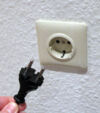What to take on a self-supported cycle tour along the Danube?
Here is a list of gear that you might consider for your Danube cycle tour. The list of course cannot be complete as it will not mention clothes, outdoor equipment and personal stuff, mostly. Folks who have done many self-supported cycle tours before will only fly over it. The list was written for people who just start(ed) cycle touring. And the Danube is the perfect place for your first longer cycle tour abroad.
- Waterproof panniers: Expect it to rain on one day at least. Hence waterproof panniers are essential. We recommend getting good ones, either from Ortlieb or from Vaude. There are cheaper ones but often at the costs of functionality. We prefer the good old Back-Roller Classic and Sport-Roller Classic from Ortlieb - manufactured for .. well, ages. As a rule of thumb: 2x 20 liter in the rear is fine for a week. If you travel more than that, get additional space on your front wheels (usually: 2x 12.5 liter).
- Handlebar bag: Pick one that allows to carry your maps on top and keeps them (as well as the bag's inside) dry at rain. Get a detachable one. So you can leave your bicycle behind without leaving your (most) valuable things - not counting the bicycle itself of course. If you rent a bicycle locally, don't forget to bring the adapter in order to fix the bag to the handlebar, and the tools needed (usually one or two allen keys, possibly a Phillips screwdriver).
- Rarely seen on the cycle path but worth mentioning it: a waist bag to carry your valuables. Just an idea in case you don't like to bring a handlebar bag. It should be big enough to carry your camera for taking shots from the saddle.
- Waterproof clothes: Of course. But did you think about your feet? Consider a pair of waterproof socks. SealSkinz produces very good ones. The thinest will be just right. They keep your feet dry, no matter how hard it rains.
- Padded cycle shorts: While there were cyclists in the 90's who cycled around the globe without padded shorts, get yourself this achievement of the modern. Two of those if you cycle for a week (maybe three if your journey lasts longer; depending on your laundry plans).
- Cycle helmet: You are in a foreign country with the one or other unwritten traffic rule, you admire the countryside while cycling inattentively, you are possibly not used to cycle on the right-hand side - there are many good reasons for bringing a helmet. Pick your favourite! You might even buy a helmet locally. Prices start in the area of €40/50, approx.
- Medicine: Antihistamine (like Claritin) is recommended (after getting bidden by the Mean Mosquito Danubensis), insect repellant if you like, headache pills if that's an issue, a first-aid kit incl. antiseptic cream or spray [Savlon, Bepanthen, amongst other brands], blister plasters are always a good idea, and sunscreen (SPF 30 and higher, better: 50+)
- Your European Health Insurance Card (EHIC): if you are citizen of the European Union.
- Puncture proof tyres: If using your own bicycle from home, have it equiped with puncture proof tyres. It's worth the money. We recommend Schwalbe (Marathon Plus, or Marathon Mondial if you prefer a more lightweight one). Continental's Touring Plus tyre might be just as good. The surface is mostly paved. Hence a special off-road tyre profile is not needed (in Germany and Austria).
- A socket adapter: for your electrical devises (like electric shaver, battery recharger, mobile phone)
- Little notebock: to keep records from time to time.
- A mini tripod for your camera: if you like.
What you not necessarily need:
- Cycle computer (odometer): Believe it, cycle touring is not about the pace.
- GPS devise: not needed in Germany and Austria. Get the written guidebooks and learn reading maps! :) Even in Eastern Europe, the guide book by Esterbauer provide sufficient maps.
- Rucksack (backpack): There is nothing more annoying than something on your back while cycling.
- Extensive bike repair equipment: When cycling in Germany and Austria, a cycle shop shouldn't be too far away. Be prepared to change an inner tube yourself. And make sure your bicycle is in good condition at the start. That's it.

